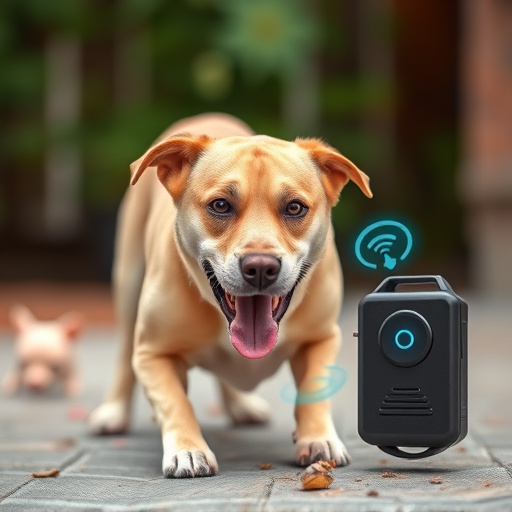Dog repellent electronic devices, utilizing high-pitched inaudible frequencies and motion sensors, offer a safe alternative to traditional repellents. To maintain optimal performance, users should regularly check battery status (indicated by LED flickering or flashing), replace batteries promptly, and adjust settings/positioning. Low battery warning systems provide peace of mind, preventing unexpected malfunctions. Safety considerations include regular battery care, overcharge protection, and temperature regulation to safeguard pets and users. Proactive battery management ensures reliable dog deterrent performance.
In today’s world, finding effective yet humane dog deterrents is essential for maintaining a peaceful environment. One innovative solution gaining traction is the electronic dog repellent device. These tools utilize safe visual and auditory stimuli to encourage dogs to stay away from certain areas. This article delves into the inner workings of these devices, highlighting their benefits and safety features, particularly focusing on crucial aspects like low battery warning signs. By understanding these indicators, pet owners can ensure optimal performance and continuous protection.
- Understanding Dog Repellent Electronic Devices: How They Work
- Benefits and Safety Considerations of Low Battery Warning Systems
- Identifying Visual and Auditory Low Battery Warning Signs
- Maintenance and Replacement: Ensuring Optimal Performance
Understanding Dog Repellent Electronic Devices: How They Work
Dog repellent electronic devices, also known as anti-dog or pet deterrents, utilize sound and/or vibration to discourage dogs from entering specific areas. These devices are designed to be humane, safe for both pets and humans, and an effective alternative to traditional, potentially harmful repellents. At their core, they work by emitting high-pitched frequencies that are unpleasant to dogs but generally inaudible to humans. This sound is triggered when the device detects movement, such as a dog approaching. Some models also incorporate motion sensors to ensure the signal only activates when necessary, minimizing false alarms and extending battery life.
Regular maintenance is crucial to ensure these devices operate optimally, including keeping an eye out for low battery warning signs. Most modern dog repellent electronic devices feature LED indicators that signal power levels. When the battery is low, these lights may flicker or flash more frequently than usual. It’s essential to replace the batteries promptly to avoid unexpected malfunctions during use. Additionally, checking the device’s settings and ensuring it’s properly positioned for maximum effectiveness are simple yet vital steps in making sure your dog repellent electronic device serves its purpose.
Benefits and Safety Considerations of Low Battery Warning Systems
Low battery warning systems in dog repellent devices offer significant benefits, ensuring users are never caught off guard by a sudden malfunction due to drained power. These systems provide peace of mind, allowing pet owners and guardians to monitor the device’s status remotely or via real-time alerts. This proactive approach prevents unexpected incidents and reinforces consistent protection for your property against unwanted canine visitors.
Safety considerations are paramount when implementing low battery warning signs. Users must be educated on the importance of regular maintenance and timely replacement of batteries to avoid any potential risks. Reliable devices should also incorporate safety features like overcharge protection, short-circuit prevention, and temperature regulation to safeguard both pets and users from harm.
Identifying Visual and Auditory Low Battery Warning Signs
When using a dog repellent electronic device, it’s crucial to be aware of potential low battery warning signs. Visually, look for any dimming or flickering of the device’s lights, which could indicate a depleted power source. Additionally, if the device’s display shows a battery icon or sends out an auditory signal – such as a beep or buzz – that signifies a low charge, it’s time to recharge. These visual and auditory cues are your dog repellent’s way of letting you know it needs attention soon.
Regularly checking for these signs is essential to ensure the device remains effective in deterring dogs. If left uncharged, a low battery could render the repellent inactive, leaving your yard or space vulnerable to unwanted canine visitors. Stay proactive and address battery life to maintain the safety and reliability of your dog deterrent electronic device.
Maintenance and Replacement: Ensuring Optimal Performance
Regular maintenance is key to keeping your dog deterrent device functioning at its best. These devices often run on batteries, so one of the primary concerns is monitoring battery life and replacing them when necessary. Look out for signs such as reduced spray intensity, irregular operation, or a low battery indicator—all hinting that new batteries may be required.
Timely replacement is crucial to avoid any potential deterrence gaps. Most manufacturers provide guidelines on battery lifespan and offer compatible replacements. Staying on top of these maintenance tasks ensures the device remains effective in keeping unwanted visitors away from your property, providing peace of mind for pet owners and a humane alternative to traditional repellents.
Electronic dog deterrent devices, especially those with low battery warning systems, offer a humane and effective way to keep dogs away from sensitive areas. By understanding how these devices operate and being aware of visual and auditory signs of low battery, users can ensure optimal performance and maintain a safe environment. Regular maintenance and timely replacement are crucial for the system’s effectiveness, making it a reliable solution for managing dog access.
